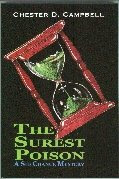Chester Campbell, author of The Surest Poison

Welcome to Chester Campbell, today’s guest blogger, whose writing career has spanned sixty years. His latest work is a mystery novel titled The Surest Poison, just published by Night Shadows Press. In it, three seemingly unrelated murders crop up during the investigation of a toxic chemical dump that plagues a rural community west of Nashville. PI Sid Chance is hired to find the party responsible for the pollution behind a small plant whose current owner is being harassed by the state. Sid is tailed, threatened, and shot at before encountering some nasty guys from his past.
In her Agatha Award-winning book Don’t Murder Your Mystery, Chris Roerden says, “Talking that offers no resistance, no characterization, and no meaningful interaction to move the story forward is not dialogue.”
So what is dialogue? To start with, it’s one of the most potent arrows in the writer’s compositional quiver. Dialogue is a form of action that can make your characters come alive.
If your dialogue is snappy, adversarial, and oblique, your manuscript has a good chance of getting past the screeners who are first readers at literary agencies, Roerden says. The object is to make those words between the quotation marks give clues to the speaker’s personality as well as provide a forward push in the direction the plot is taking. It’s an opportunity to portray characters directly, through their own voices.
As with any area of writing, there are some cautions. The voices need to sound natural, the way people really speak, but without all the meaningless trivia that we throw into everyday conversations. And a little bit of colloquialism goes a long way. One or two “ain’ts” is enough to brand a character.
Another pitfall to beware of is using dialogue for a data dump. Avoid continuous paragraphs of one speaker. Break it up with a question for clarification or an action by one of the characters. You can also intersperse paraphrases with dialogue. If you’re trying to create tension, don’t let it fizzle through information overload. As Roerden puts it:
“A data exchange is a tension deficit disorder.”
In the opening chapter of my new mystery, The Surest Poison, my private investigator, Sid Chance, frustrated, runs off to his remote cabin for a few days. As soon as he returns home, he gets a call from Jaz LeMieux, a wealthy businesswoman and former cop who got him into the PI business and becomes a part-time associate. You get a feel for the characters in this brief exchange:
“Glad you finally decided to answer.” Jaz LeMieux’s voice had an edge.
“I just got home a little while ago.”
“From where?”
“The cabin.”
“Don’t you answer your cell phone?”
“When it’s turned on.”
There was a pause. “I think you’re reverting to your mountain man persona, Sid.”
He said nothing.
“Have all my efforts been wasted?”
“I did a lot of pondering last night,” he said. “But I came back.”
There are a few points to mention about this. In the first line, the attribution is done through a separate sentence describing Jaz’s tone of voice. Otherwise, there is no attribution until the last line, “he said.” With only two speakers, it’s obvious who is talking, partly because what is said. Jaz is miffed and Sid is close-mouthed. Their relationship mellows during the story, but the tension pops up now and again.
He said and she said are about all that’s needed, except for asked, in tagging your speakers. It’s more interesting to tag them with actions in a follow-up sentence. And if you use said, don’t rely on an explanatory adverb but make the dialogue strong enough to stand on its own.
Like most PI novels, mine are heavy on dialogue. That’s what investigators do mostly, buttonhole witnesses and suspects and pump them with questions. And if done well, it helps make the story and the character come alive. Do you have a favorite tip regarding dialogue?
Today’s visit is part of Chester Campbell’s Blog Book Tour. He will give away several copies of his books in two drawings during the tour, which runs through May 1. Leave a comment here and you may be a winner. The first drawing will be tomorrow for two winners of autographed copies of The Surest Poison. For more details go to his website at http://www.chesterdcampbell.com/BlogTour.htm.


Comments
Marilyn
a.k.a. F. M. Meredith